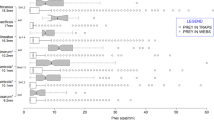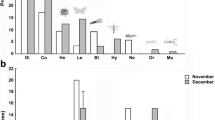Summary
Philoponella oweni (Uloboridae) is a facultatively communal spider found in the southwestern United States. Solitary females and communal groups of females coexist in the same habitats. Communal females are known to produce more eggs than solitary females. Communal females might acquire the energy for the production of additional eggs by one of three means: they might have a longer life span, and thus more time in which to acquire energy; web maintenance might be more efficient in a communal group; or communal females might spend more time feeding. Field data from a marked population in Arizona showed the third alternative was true.
Two possible causes for the greater time spent feeding by communal females were investigated; either the communal web or group is a more efficient trap for insects, or the communal groups are located at sites where insects are more abundant. Analysis of feeding rates and sticky trap data confirmed the second alternative.
Potential web attachment sites are limited in some habitats, and mortality during dispersal is very high. When potential web attachment sites are scarce more of the population is found in communal groups; when they are abundant more of the population is solitary. The pattern of dispersal and overwintering is this species suggests that females renewing a colony in the spring could be related.
Similar content being viewed by others
References
Altmann J (1974) Observational study of behavior: sampling methods. Behaviour 49:227–265
Barr AJ, Goodnight JH, Sall JP, Helwig JT (1976) A user's guide to SAS 76. SAS Institute, Raleigh (North Carolina)
Buskirk R (1975) Coloniality, activity patterns and feeding in a tropical orb-weaving spider. Ecology 56:1314–1328
Chacon P, Eberhard WG (1980) Factors affecting number and kinds of prey caught in artifical spider webs, with consideration of how orb webs trap prey. Bull Br Arachnol Soc 5:29–38
Daniel B (1978) Applied nonparametric statistics. Houghton Mifflin, Hopewell (New Jersey)
Lahmann BJ, Eberhard WG (1979) Factores selectivos que afectan la tendencia a agruparse en la araña colonial Philoponella semiplumosa (Araneae: Uloboridae).Rev Biol Trop 27:231–240
Marples BJ (1962) Notes on the spider family Uloboridae. Ann Zool 4:1–12
Muma MM, Gertsch WJ (1964) The spider family Uloboridae in North America north of Mexico. Am Mus Novit 2196:1–43
Riechert SE, Tracy CR (1975) Thermal balanceand prey availability: bases for a model relating web-site characteristics to spider reproductive success. Ecology 56:265–284
Rodman PS (1981) Inclusive fitness and group size with a reconsideration of group size in lions and wolves. Am Nat 118:275–283
Rypstra AL (1979) Foraging flocks of spiders. A study of aggregate behavior in Cyrtophora citricola Forskal (Araneae: Araneidae) in West Africa. Behav Ecol Sociobiol 5:291–300
Siegel S (1956) Nonparametric statistics for the behavioral sciences. McGraw-Hill, New York
Smith DRR (1982) Reproductive success of solitary and communal Philoponella oweni (Araneae: Uloboridae). Behav Ecol Sociobiol 11:149–154
Smith Trail D (1980) Predation by Argyrodes (Theridiidae) on solitary and communal spiders. Psyche 87:349–355
Turnbull AL (1962) Quantitative studies of the food of Linyphia triangularis Clerck (Araneae: Linyphiidae). Can Entomol 94:1233–1249
Uetz G, Biere MJ (1980) Prey of Micrathena gracilis (Walckenaer) (Araneae: Araneidae) in comparison with artifical webs and other trapping devices. Bull Br Arachnol Soc 5:101–107
Wise DH (1979) Effects of an experimental increase in prey abundance upon the reproductive rates of two orb-weaving spider species (Araneae: Araneidae). Oecologia (Berl) 41:289–300
Author information
Authors and Affiliations
Rights and permissions
About this article
Cite this article
Smith, D.R.R. Ecological costs and benefits of communal behavior in a presocial spider. Behav Ecol Sociobiol 13, 107–114 (1983). https://doi.org/10.1007/BF00293800
Received:
Accepted:
Issue Date:
DOI: https://doi.org/10.1007/BF00293800




